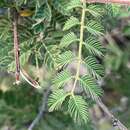Comprehensive Description
provided by North American Flora
Mimosa dysocarpa Benth.; A. Gray, PI. Wright. 1: 62. 1852
A shrub, the twigs angled, brownish villous, very prickly, the prickles stout, light-colored. Pinnae 6-12 pairs; leaflets 7-16 pairs, oblong-linear, acute, pubescent on both sides; spikes 1-2 cm. long; calyx and corolla pubescent; legume 2.5-5 cm. long, about 6 mm. wide, tomentose, more or less constricted between the seeds, the margin prickly; stamens twice as many as the corolla-lobes.
Type locality: Pass of the Limpia. Texas.
Distribution: Southern Texas and New Mexico to Arizona and Durango.
- bibliographic citation
- Nathaniel Lord Britton and Joseph Nelson Rose. 1928. (ROSALES); MIMOSACEAE. North American flora. vol 23(1). New York Botanical Garden, New York, NY
Comprehensive Description
provided by North American Flora
Mimosa wrightii A. Gray, PI. Wright. 2: 52. 1853
A shrulj, the twigs angled, pubescent and prickly, the prickles brown. Pinnae 7-10 pairs; leaflets 10-15 pairs, linear or narrowly oblong, 3-4 mm. long, acute, glabrate above, appressedpubescent beneath; spikes 3-4 cm. long; calyx and corolla pubescent; legume 3-5 cm. long, 5-6 mm. wide, densely tomentose, unarmed; stamens twice as many as the corolla-lobes.
Type locality: Sonoita, Sonera.
Distribution: Southern Arizona, Sonora, and Chihuahua.
- bibliographic citation
- Nathaniel Lord Britton and Joseph Nelson Rose. 1928. (ROSALES); MIMOSACEAE. North American flora. vol 23(1). New York Botanical Garden, New York, NY
Physical Description
provided by USDA PLANTS text
Perennial, Shrubs, Woody throughout, Stems woody below, or from woody crown or caudex, Taproot present, Nodules present, Stems erect or ascending, Stems or branches arching, spreading or decumbent, Stems prostrate, trailing, or mat forming, Stems less than 1 m tall, Stems 1-2 m tall, Trunk or stems armed with thorns, spines or prickles, Stems solid, Stems or young twigs sparsely to densely hairy, Stems with hooked uncinate hairs or prickles, Leaves alternate, Leaves petiolate, Stipules conspicuous, Stipules setiform, subulate or acicular, Stipules persistent, Stipules free, Leaves compound, Leaves bipinnate, Leaf or leaflet margins entire, Leaflets opposite, Leaflets 10-many, Leaves hairy on one or both surfaces, Flowers solitary in axils, or appearing solitary, Inflorescences racemes, Inflorescences spikes or spike-like, Inflorescence axillary, Flowers sessile or nearly so, Flowers actinomorphic or somewhat irregular, Calyx 5-lobed, Calyx gl abrous, Petals united, valvate, Petals white, Imperfect flowers present, dioecious or polygamodioecious, Stamens 9-10, Stamens completely free, separate, Stamens long exserted, Filaments glabrous, Filaments pink or red, Style terete, Fruit a legume, Fruit a loment, jointed, separating into articles, Fruit unilocular, Fruit freely dehiscent, Fruit elongate, straight, Fruit oblong or ellipsoidal, Fruit strongly curved, falcate, bent, or lunate, Fruit exserted from calyx, Fruit compressed between seeds, Fruit spiny, bur-like, with hooked bristles or prickles, Fruit hairy, Fruit 3-10 seeded, Seed with elliptical line or depression, pleurogram, Seeds subquadrate, Seed surface smooth, Seeds olive, brown, or black.

